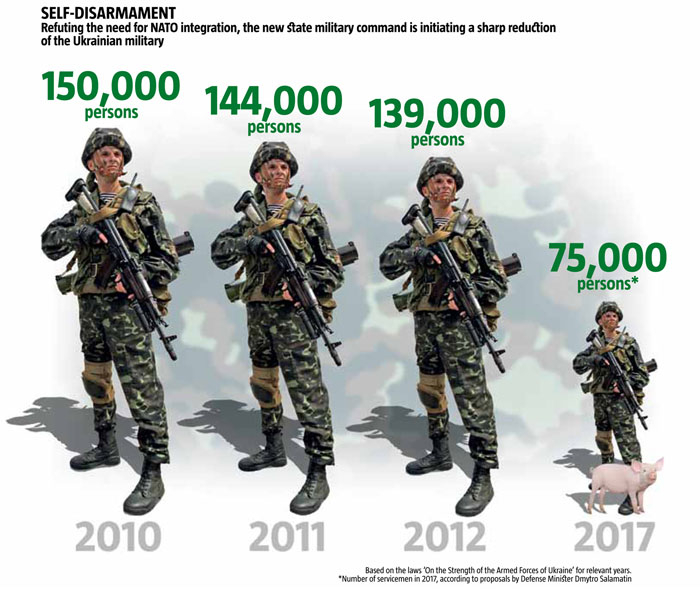Viktor Yanukovych recently ratified two decisions by the National Security and Defense Council of Ukraine dated 8 June 2012 ‘On a New Military Doctrine’ and ‘On a New National Security Strategy’. The doctrine’s key drawback is that it can identify threats, but does not provide a mechanism for responding to them.
Much like the previous military doctrine, this new one does not name potential state enemies and is limited to the following criteria for their identification: a potential enemy is deemed to be one whose actions or intentions indicate a threat of military force against Ukraine. It is worth mentioning that according to the criteria of ‘war and political risks or provocation’ stipulated in Clause 10 of the document, Russia represents a primary threat (See Portrait of the Enemy below). After all, the parliament of the Russian Federation voted for official acts containing territorial claims to Ukrainian land, President Medvedev signed laws outlining simplified procedures for Russian military deployment beyond state borders, and the Russia maintains large-scale informational and economic (energy, milk, etc.) wars against Ukraine.
IRRESPONSIBLE ‘NON-ALIGNED’ STATUS
The New Military Doctrine and National Security Strategy are based on the idea of Ukraine’s non-aligned status—meaning its refusal of NATO integration. Some are trying to present this as an advantage for Ukraine, claiming that non-aligned status means closed doors for the pro-Russian Collective Security Treaty Organization (CSTO). However, this February, CSTO Secretary General Nikolay Bordiuzha announced the organization’s readiness for ‘more active collaboration’ with Ukraine.
The problem is that non-aligned status comes at great cost, requiring additional expenditures. Thus, declaration of non-aligned status for a country with a chronically underfunded military means irresponsibility at the very least, or could even signal intentional sabotage. During the last several years, it has become obvious that the authorities are practically destroying the Armed Forces of Ukraine, as the country has undergone an unprecedented process of ‘voluntary disarmament’. As of 2012, defense expenditures comprised just UAH 14.171bn, while over UAH 12bn of this sum was spent on consumption and only UAH 2.141bn was set aside for development.
This means that almost 85% of the general army’s funds account for personnel salary expenditures, utility services, medical treatment, nutrition, and construction of housing for servicemen. As of 2012, Ukraine allocates in total around USD 2bn for general and specific army funds, while only USD 1.82mn is allocated for technical modernization. Meanwhile, one Ukrainian ‘Oplot’ tank costs UAH 25mn. In contrast, Russia’s 2012 defense budget comprises about USD 72bn, while Moscow plans to allocate USD 795bn by 2020 for the development of new armament systems alone.
RUINATION FROM WITHIN
It is not only financial factors that are causing national security problems. There are also some very alarming indications of anti-national strategies regarding state policies on military industry, in particular manpower policies. The issue concerns Defense Minister Dmytro Salamatin. He was a Russian citizen until 2005, and proved himself a true warrior in Ukraine during the 2010 battles for Russian interests taking place in the Ukrainian parliament. Mr. Salamatin even broke the nose of opposition deputy Volodymyr Karpuk during the vote on the Russia-Ukraine Kharkiv agreements on the Black Sea Fleet. According to The Ukrainian Week’s sources, Salamatin has repeatedly voiced Ukrainophobic and openly pro-Russian views in private conversations.
Several months ago, some clauses of the draft ‘Concept for the Reformation of the Ukrainian Armed Forces’ were published in the mass media, signed by the Defense Minister just after he was appointed to the post. The draft concept envisages active disarmament and reduction of the Ukrainian Armed Forces along with the country’s non-aligned status. Ukraine is currently cutting the number of its Armed Forces down by 8,000 persons, meanwhile Mr. Salamatin has proposed reducing it by 20,000 persons, so that Ukraine would have 75,000 servicemen, 100 aircraft and 270 tanks by 2017. In comparison, Ukraine’s neighbor Romania has only half the population of Ukraine and maintains Armed Forces comprising 90,000 persons, while also functioning as a NATO member-state.
Mr. Salamatin’s recent actions invite blatant mockery of Ukraine’s defense capabilities and army. Lately, there have been rumors in the media about a draft law on the reformation of military bases that envisages 78 categories of military base administrative activity, including raising poultry, pigs, sheep, and goats.
PORTRAIT OF THE ENEMY
The following risks signaling increased threat of military force against Ukraine were listed in the Military Doctrine:
- Territorial claims;
- Claims or efforts to review existing state borders;
- Increase of military troops and arms near Ukraine’s borders, establishment of new military bases or development and modernization of current ones;
- Establishment and purchase of new offensive armament systems and military equipment, as well as modernization of current ones, which could disrupt the balance of power;
- Activation of intelligence activities by foreign governments and organizations against Ukraine;
- Informational and psychological efforts aimed at destabilizing the socio-political climate, religious and ethnic relations in Ukraine or its regions densely populated by national minorities;
- Political and economic sanctions against Ukraine;
- Use of military force in the region or with the participation of the region’s states;
- Support of separatism;
- Justifying use of military force as a means of international conflict resolution;
- Weakening of legislative restrictions on the use of military force beyond national borders;
- Violation of international agreements and treaties on non-proliferation of weapons of mass-destruction, methods of their delivery, control over armament, arms limitations and reductions, or withdrawal from these treaties (ceased participation);
- Inducing escalation of military conflicts in the region.


